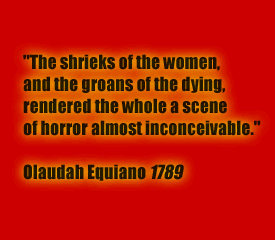
Origins:
African Heritage
and the Slave Trade
TOPICS >>>
Asiento-- license to trade
slaves across the Atlantic to the Americas
Ancient Ghana (10th-11th century AD)
Ancient Mali
Ancient Songhai
Ashanti kingdom (Ghana)
Gorée Island, Senegal
African music, dance, religion and other cultural elements
within black American culture
Prejudice:
Discrimination by one group
against another
Intolerance:
Antisocial discrimination; the
dynamics of recantation, conversion, isolation/extermination
Race:
A division of humanity justified
by phenotype (physical characteristics, color, genetics/biology)
which implies a hierarchy of power/rights/privilege
Institutional Racism:
The systematic subordination
of an entire category of people--ideologically, politically
and socially--
and the exploitation of their labor. (labor, physical isolation-segregation/ghettoization,
ideological/cultural;
coercion-lynching; political subordination; personal discrimination)
Roots of slavery in Western Civilization:
Slavery in classical antiquity/ancient
Greece-- 600 BC
Aristotle's defense of slavery
Slaves are "property with a soul"; Aristophanes "pais"=boy/ "paiein"=to
beat
Impact of the Transatlantic Slave Trade:
15 Million Slaves; 650,000 slaves
to the US, 1619-1861
Colonial Slavery:
Indentured servitude; free labor;
chattel slavery
Virginia Slave Code of 1694 South Carolina Slave Laws of 1686, 1722, 1741
Pennsylvania Slave Laws of early 1700s
Thomas Jefferson and the contradiction between slavery and democracy
Declaration of Independence--1776
Constitution of the United States--1787
Article One, Section 2; Article One, Section 9, and Article Four, Section
2
Slavery in the Nineteenth Century:
Forms of Labor Discipline: limited
coercion/punishment;
The whip; sexual abuse/rape; disruption of families, sale of children
Slave Conspiracies and Revolts:
Colonial Virginia, Gabriel Prosser's
Revolt-1800;
Pointe Coupee, Louisiana, 1811; SW Florida-1815-1816;
Denmark Vesey's Conspiracy--1822;
Nat Turner's Revolt in Virginia, 1831
Day-to-Day Resistance:
Work slowdowns, pretending to
be ill,
breaking farm tools, self mutilation,
pretending mental disorders to prevent sale, etc.
Black Women's Resistance:
Sexual abstinence, abortion,
infanticide
Culture as a weapon of resistance:
Music-- spirituals
and secular/field songs;
Humor against the master;
Folktales-- Brier Rabbit/Trickster tales,
The role of the African-American Church; the development of craftsmen/artisans
READINGS >>>
Vincent Harding, There
Is A River, Chapters I and II, pp. 3-51.
Manning Marable and
Leith Mullings, eds., Let Nobody Turn Us Around,
"Introduction," pp. xvii-xxv; Section One, "Introduction," pp. 3-7; Number
1, pp. 7-16;
Number 6, pp. 41-42; Number 8, p. 48; and Number 9, pp. 49-50.
MULTIMEDIA >>>
Music:
Traditional West African Music (Senegal,
Ghana, Nigeria, Ivory Coast, etc.)
Film:
Steven Spielberg's
Amistad, clip of Cinque's capture and transatlantic slave trade.
Roots Ð television
clip of first segment, depicting traditional Africa, Kunta Kinte's capture
and slave ship across the Atlantic
|










